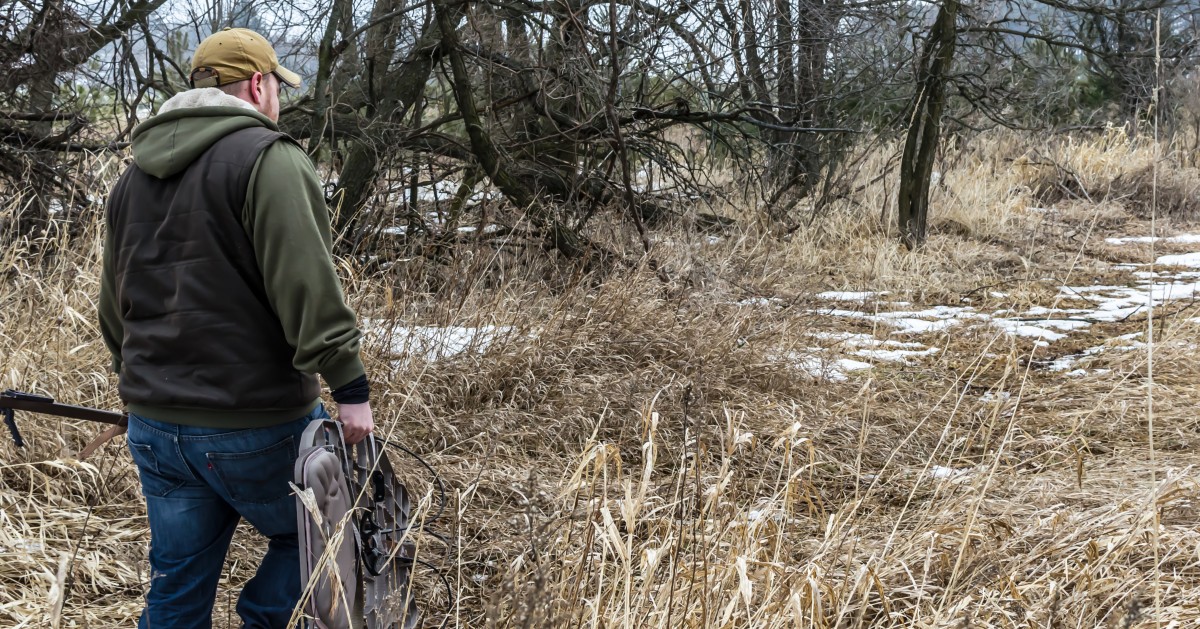Shed hunting, spring turkey prep and warm weather are undoubtedly a few great things every outdoorsman loves about springtime. For the dedicated whitetail hunter, spring is prime-time for scouting out new stand locations for the upcoming fall. While on stand during the fall, I often realize that I am hunting not only for the present, but also continually analyzing deer movement to make notes for the future.
Once spring finally rolls around, you can scour an entire property worry free and implement any necessary changes for the upcoming season. Oftentimes these changes include adjusting stand locations. The factors that influence these tweaks from season to season are countless. Stand access, prevailing wind, past encounters, and proximity to food and bedding are all critical elements to great stand placement.
Perhaps nothing is more important than stand entry and exit routes. We hear it all the time, but without the ability to enter and exit a stand undetected, our chances for harvesting any deer diminish greatly. Spring is a great time to think critically about how you should be going to and from your stands. Stealthy entry routes can include creeks, ditches, and open crop fields.
 A ditch or low area like this can be a great way for a hunter to get deep into a property without busting all the deer.
A ditch or low area like this can be a great way for a hunter to get deep into a property without busting all the deer.
During an evening sit, creeks and ditches are my preferred route. As air cools, thermals fall downhill and collect at the lowest point. If deer are bedded above you, they stand virtually no chance of smelling you. Keep in mind deer like to bed lower in the evening to take advantage of these falling thermals, this is where trail cameras will give you intel as to exactly where they are bedding. In hilly terrain, steep ditches and meandering low points provide excellent access to stands located deep in timber.
I have discovered bucks in areas I hunt love to bed on the ‘top third’ of benches and ridges. The reasons are twofold: from this location on a ridge deer can utilize eyesight to see downhill, while also taking advantage of a consistent wind direction. Crop fields and food plots can also be excellent ways to enter a stand during an evening sit. Your exit from fields will most likely be much more difficult if deer are out feeding. If feasible, have a buddy come pick you up in a vehicle. Yes, vehicles are disturbing, but they don’t do near as much damage compared to if you were to bust the field on your climb down or walk out. Educating deer by allowing them to see or smell you is never a fabulous idea.
 The wind on ridgetops is often much more consistent compared to the swirly winds found in valleys.
The wind on ridgetops is often much more consistent compared to the swirly winds found in valleys.
I’ve touched on wind some already, but if you don’t have a solid, consistent wind for a stand site, it’ll be difficult to kill mature bucks on a consistently. Hunters can absolutely get away with swirling, unfriendly winds, but all in all you need to have the powers in your favor. I have only killed one buck during a bad wind and this was simply due to the fact that he was running after a doe during the middle of the rut and was a careless, over anxious three year old. That rarely happens and hunters (specifically bow hunters) cannot count on those events playing out in their favor very often.
When catering stands to wind direction, I look at two factors. Prevailing wind and rising and cooling thermals (in hilly country). If my stand location carries wind to a feeding or bedding location, it is probably a spot I should avoid. Additionally, if thermals aren’t in my favor, I will attempt to move as well. Thermals can be pesky and you’ll want to pay attention to how these slow moving drafts will affect your hunting.
Stand proximity to food and bedding is very important as well. Locations too close to bedding are risky, but given the right opportunity, can be a slam-dunk. Springtime provides us with great opportunities to walk a property and try to piece together how deer are moving from feeding to cover and vice versa. Important factors to consider are natural funnels. In my frequented hunting spots, natural rock formations and steep hillsides provide a predictability factor to my hunts. Deer have no choice but to navigate around rock formation and a properly placed tree stand will see traffic at all times of the year, especially during the rut. For those hunting flatter ground, you must get creative in order to congest deer traffic to a specific area. It could be as simple as cutting the top strand of an old fence or re-locating cut timber and lining a barrier leading deer close to a stand. For more creative ideas on how to manipulate deer movement check out – Creating Mousetraps for Deer.
 A rock outcrop like this can often funnel deer around it, thus making a good spot to hang a stand.
A rock outcrop like this can often funnel deer around it, thus making a good spot to hang a stand.
Springtime stand scouting allows the mind to get creative and affords time to plan for the upcoming fall. Hunters who find their next great stand location typically don’t wait until August to do so. Most successful hunters plan their next moves during the current season, and act on them once spring and early summer arrive. Adjusting your stand locations now ensures you’ll be prepared for the 2016 season with plenty of time to work on other whitetail related projects.







